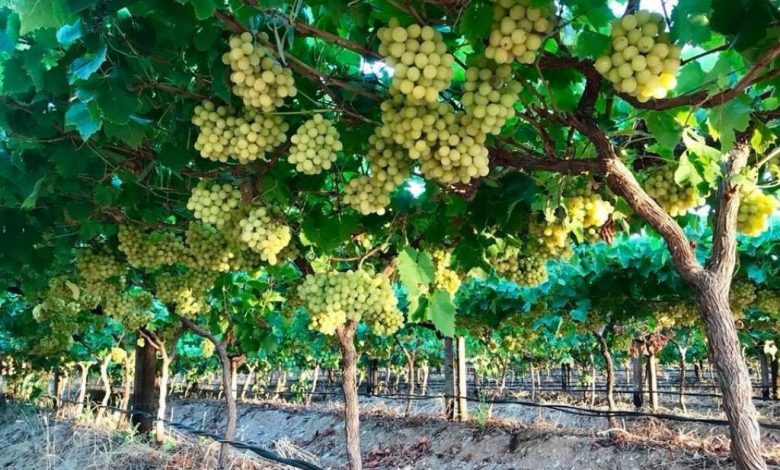
Grapes cultivation is a famous commercial crop in India as well as in the world. The worldwide farmers cultivate this deciduous woody climbing vine. In addition, Grapes are a rich vitamin B and minerals source, including calcium, phosphorus, and iron. We can use it for raw eating or make several products from it like vinegar, juice, jelly, jam, raisins, seed oil, and grape seed extracts. France, the USA, China, Portugal, Turkey, South Africa, Argentina, Italy, Iran, and Chile are the primary producers of grapes worldwide. Among all the countries, China has the first place to produce grapes. Consuming grapes can control diabetes, constipation, relieve asthma, heart issues, bone health, and more. It can also protect your skin and hair.
Methods and Requirements Grapes Cultivation
You can practice grape cultivation in a variety of soil. However, you have to cultivate it in good fertile soil with a 6.5 – 8.5 pH range and good water holding capacity for maximum production. Only soil is not a way to obtain more outstanding production, but also you have to prepare it by using different types of implements like a rotary tiller, plough, etc. If you are a marginal farmer, then take a tractor loan from a reputed bank to buy it.
Popular Varieties
Several varieties of grapes are available in India for cultivation. We are here with some of them. Let’s scroll a bit and know them.
- Punjab MACS Purple – Released in 2008, become purple at maturity, matures in the first week of June, and is suitable for juice and nectar
- Perlette – Released in 1967, wide yielding variety and an average yield of 25kg per vine
- Beauty Seedless – Released in 1968, matures in the first week of June and an average yield of 25kg per vine
- Flame Seedless – Released in 2000, becomes light purple at maturity and matures in the second week of June
- Superior Seedless – Medium spreading vines, seeds are golden, and fruit contains 10.0% sugar, matures in the first week of June, and an average yield of 21.8 kg per tree
- Thompson Seedless – For making raisins and raw eating
- Black Sahebi – For making raisins and raw eating
- Beauty Seedless – For raw eating and juice making
- Anab-e-Shahi – For raw eating, milk colour fruits and sweet in taste
- Black Prince – For juice making & raw eating, purple fruits, round-shaped, good yield giving an early variety,
- Rangspray – For making vine
- Cholhu White – For making vine
- Cholhu Red – For making vine
- Perlette
- Delight
- Himred
- Thompson Seedless – Grapes are medium-long. Green fruits turn golden at maturity, and late-maturing variety
- Black Sahebi – Fruit is purple and can be kept long. Less fruit yield, large-sized fruit
Land Preparation
You must prepare the land for grape cultivation with excellent farming implements and equipment, including tractors and other tools. So, if you are needy for a used tractor for your small farm, you also can get a Used Tractor Loan. It can save you from different types of headaches to manage your budget. When you own or rent a tractor, you should apply 3 to 4 ploughing and follow it by harrowing to bring the soil to a fine tilth.
Sowing
December to January is an ideal time for transplantation. The best-suited method for Grape cultivation is the Knifing method and keep the space 3 m X 3 m. You can also use the arbour method, but the space must be 5m X 3m in this method. Anab-e-Shahi variety needs a spacing of 6m X 3m. Moreover, you should plant the cuttings at a depth of 1m.
Irrigation
In the 1st fortnight of February, the first irrigation is good after pruning. After that, the second irrigation must be in the first week of March. Then, when the fruit is set in April to the 1st week of May, give irrigation at 10 days. Now, you have to rinse the field weekly during the rest of May. Moreover, in June, give it at 4 days intervals. Then, you should rinse the area if rainfall is insufficient from July to October. And lastly, provide one irrigation if the soil gets totally dry from November to January.
Plant Protection
Plant protection is the way to save your crop from different types of diseases and pests. Let us tell you the way to solve this problem.
Pest and their control:
- Beetles – Spray of Malathion @ 400ml per 150ltr water
- Thrips and Jassids – Spray of Malathion @ 400ml per 150ltr water
- Leaf roller – Spray of Quinalphos @ 600ml per 150ltr water
- Yellow and red wasp – Spray of Quinalphos @ 600ml per 150ltr water
Disease and their control:
- Powdery mildew – Spray of Carbendazim @ 400gm or wettable sulphur @ 600gm
- Downy mildew – Spray of Mancozeb@400-500gm
- Anthracnose – Spray of copper oxychloride or M-45 @ 400gm per 150ltr water
Harvesting
Harvest the field when fruits get fully mature. Depending upon varieties, check the maturity according to their maturing colours and shapes.
We hope that we could convey the information to you. If you are happy with this blog or can help you, stay tuned with us. We will come with our next blog soon.




